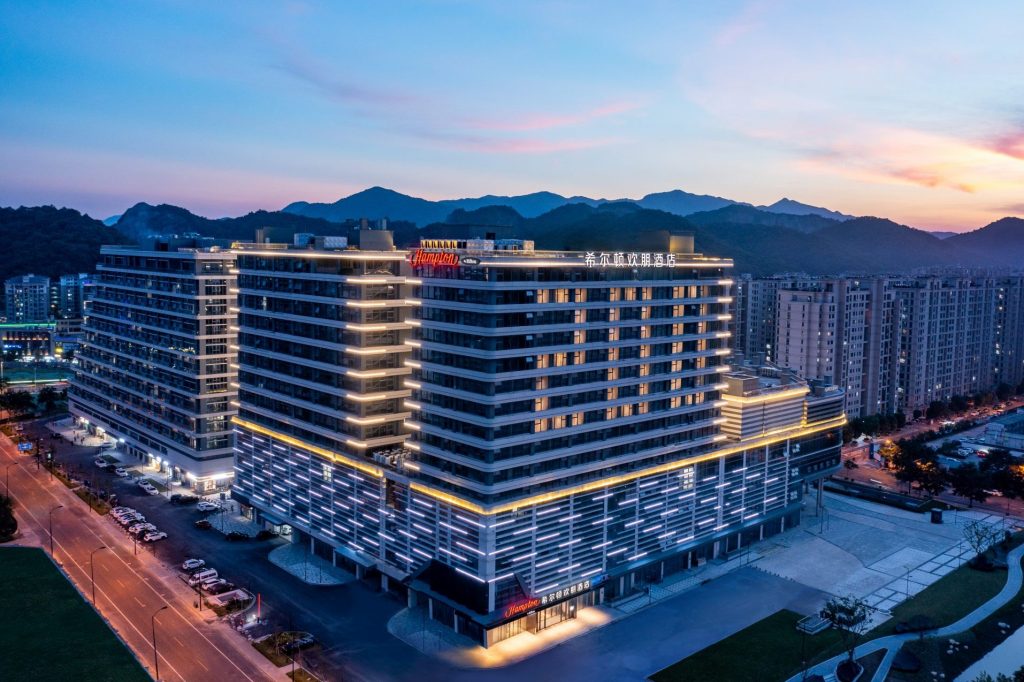Skift Take
Don't rule out the little players. Small and medium-sized businesses are largely back on the road, and that's helping lift Hilton's profit margins.
Leisure travel continues to be the strongest performer for Hilton, but a revival in business travel — particularly from smaller companies — sent the company’s profits soaring in recent months.
Hilton reported Wednesday a $240 million profit for the third quarter, the company’s second consecutive quarter of profitability during the pandemic. Leisure travel dominated the recovery, with bookings in line with 2019 levels and rates for that sector even exceeding pre-pandemic levels.
But business travel is kicking back into gear, giving the company a much-needed boost after several devastating quarters during the health crisis.
“Business transient will continue to move up,” Hilton CEO Christopher Nassetta said on an investor call. “You’ll continue to see great strength in small and medium enterprises, which aren’t fully back to pre-covid levels but are pretty close.”
Not all business travel is roaring back to life. Demand from major corporate clients is roughly 40 percent off 2019 levels, but Nassetta doesn’t appear to be losing much sleep over the suppressed line of business.
Hilton increasingly tried to win more business from small and medium-sized companies before the pandemic, and that has translated into a faster recovery during the pandemic. Many of these businesses don’t have the luxury of being able to entirely work remotely and had to stay on the road and work in person. Nassetta claimed 70 percent of U.S. businesses are now back on the road.
Demand from smaller businesses are only five to 10 percent off 2019 levels, he added. Because the company has focused so much on this business line rather than major corporate contracts, Hilton’s overall business transient demand is at 90 percent of pre-pandemic levels.
Roughly 80 percent of Hilton’s pre-pandemic business transient demand came from these kind of smaller businesses while major corporations made up the remaining 20 percent. Nassetta estimated that will likely end up being a 90-10 split in the future.
“We’ve continued our work from before Covid to further increase our focus on this segment of demand,” he added. “This demand is higher rated and more resilient, which has helped us recovery more quickly in business transient and should drive rate compression in the future as larger corporate travel picks up.”
A Growth Story
The company’s other notable gains came from its portfolio growth. Hilton inked new deals for 23,600 rooms in the third quarter and added 14,700 rooms. The company’s net rooms growth from the same time last year was 6.6 percent — significantly higher than the negligible growth competitor IHG Hotels & Resorts reported last week.
Analysts at firms like Truist Securities noted Hilton’s strength this quarter stemmed from its “category killer” line-up of affordable, limited-service hotels like Homewood Suites, Home2 Suites, Hampton, and Tru. These hotels don’t have amenities of a full-service hotel like spas or restaurants, but they also don’t require the same level of staffing, often leading to higher margins.
Both Homewood and Home2 Suites saw average occupancies exceed 80 percent in the third quarter while Hampton and Tru exceeded 70 percent.
Hilton’s Asia Pacific occupancies averaged just shy of 50 percent in the third quarter while the U.S. was nearly 68 percent and Europe slightly exceeded 59 percent.
Revenue per available room, the industry’s key performance metric, also reflected the zero-tolerance approach to new cases in China. Hilton’s overall rooms revenue was 19 percent off 2019 levels, with the U.S. down 14 percent, China down 25 percent, and Asia Pacific down 41 percent.
Hilton leaders are by no means giving up on China: Most of the company’s development pipeline is outside the U.S., and the company launched a large-scale franchise initiative for Hilton Garden Inn in China on top of its ongoing development push for Hampton and Home2 Suites in the market.
“There have been RevPAR spikes up and down in China as they go into lockdown, but the development trajectory there continues to be solid and improve,” said Kevin Jacobs, Hilton’s chief financial officer.
A Swift Recovery
There was little time given on the call to the Delta variant and its impact on Hilton’s recovery. Nassetta largely chalked up some occupancy declines over the third quarter to normal seasonality rather than the more contagious strain of coronavirus that enacted a fresh wave of mitigation measures around the world.
The Hilton leadership team primarily saw Delta’s impact on group bookings, but they remain confident in that sector picking up next year.
Hilton leaders have been among the most bullish on the travel industry’s recovery from the pandemic. Nassetta last month at Skift Global Forum predicted business travel demand would exceed 2019 levels in three years, and that optimism resonated Wednesday with respect to the entire hotel industry’s recovery.
Compared to previous cycles, the pandemic recovery is poised to be a swift one due to the industry’s concerted effort to maintain rates throughout the crisis rather than offer steep discounts to woo potential guests.
“Things are going to come back faster than prior recoveries here,” Nassetta said. “Typically, it’s a grind to build back occupancy, and rate lags significantly. Rate is leading the charge here.”
Have a confidential tip for Skift? Get in touch
Tags: coronavirus, coronavirus recovery, earnings, hilton
Photo credit: Part of Hilton's strong quarter stemmed from strong occupancy at brands like Hampton (pictured). Hilton
